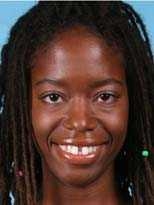AliciA Jillian Hardy entered MIT in the fall of 1995 as one of the handful of freshmen who come to the Institute planning to major in the humanities.
Although she loved MIT's writing program, she eventually switched her major to mechanical engineering. She stayed in the department for 12 years, and earlier this month she became the first black American woman to earn a Ph.D. from MIT in that field.
She's now doing a six-month internship at BMW in Munich, but she hopes to eventually use her degree to develop technologies to improve the cleanliness of power generation, particularly in developing nations. "As developed nations, we have a responsibility to help developing nations to make sure their power generation is clean," she said.
In March, she will start her new job at GE, where she will be working on biofuel technology. Hardy's master's thesis focused on improving the efficiency of large-scale hydrogen and methane power plants, which could be useful in industrializing nations that now burn a lot of coal, such as China and India.
Hardy says she enjoyed her time at the Institute even though she wasn't sure she wanted to attend MIT in the first place. As a high school student in Philadelphia, where she attended public schools, Hardy won numerous math and science awards and was recruited by many colleges.
"I applied to every possible school I could," she said. In the end she had 14 offers and couldn't decide which one to accept. Her older brother, Cordell, encouraged her to attend MIT because it was "the best possible school."
She hesitated because she wanted to study writing but went along with her brother's suggestion. She ended up loving MIT's writing program. "It's a great writing program," she said. "The lecturers and professors are excellent."
However, toward the end of her sophomore year Hardy decided to make the jump to engineering, because she wanted to be sure she could get a good job after graduation. "Writing you can always go back to," she said. "I had the chance to change, so I decided I should do it."
Hardy ended up doing all of the coursework for a major in writing except for the thesis. Taking so many classes in the writing program turned out to be very beneficial for her personal development, she said. "There's another side of you that's not expressed if you only do engineering the whole way through."
Being part of the writing program also helped Hardy feel like she belonged to a small community, which she said is important at a large institution like MIT. She also found homes as part of the women's crew, Experimental Studies Group and as a teaching assistant for Course 18.02 (Multivariable Calculus).
She earned her bachelor's degree in 2000 and her master's in 2004. For her Ph.D. thesis, Hardy studied automotive engineering and did much of her research at the Ford Research and Innovation Center in Dearborn, Mich. Through the Ford-MIT Alliance, she worked with Ford engineers and MIT's John Heywood to investigate a new type of internal combustion engine with improved fuel-efficiency potential.
"She was able to work with a research focus on a new engine combustion technology, bring some of that work to an industrial setting, and combine those elements into her thesis," said Heywood, the Sun Jae Professor of Mechanical Engineering.
Hardy credits much of her success to the inspiration and encouragement of her mother, who holds a doctorate in education and instilled in her at a very young age the importance of education, and her brother, who is a year and a half older and has a doctorate in chemical engineering.
The scarcity of black women in MIT's graduate engineering programs also inspired her to continue her studies as far as possible. She hopes to encourage others to follow in her footsteps.
"I would love to find a way to encourage more people to do it," she said. "MIT is welcoming and open to everyone."
A version of this article appeared in MIT Tech Talk on September 26, 2007 (download PDF).






